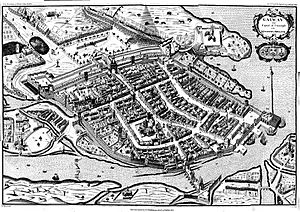Siege of Galway facts for kids
Quick facts for kids Siege of Galway 1651–1652 |
|||||||
|---|---|---|---|---|---|---|---|
| Part of the Irish Confederate Wars | |||||||
 The heavily fortified city of Galway in 1651 |
|||||||
|
|||||||
| Belligerents | |||||||
| Commanders and leaders | |||||||
| Strength | |||||||
| 2,000 soldiers | 6,000-7,000 soldiers | ||||||
The Siege of Galway happened from August 1651 to May 1652. It was a major event during the Cromwellian conquest of Ireland. Galway was the last big city held by Irish Catholic forces. When it fell, it meant that most of the organized fighting against the English Parliamentarians in Ireland was over.
The English Parliamentarians were led by Charles Coote. He was an English settler who had fought for the Parliamentarians in Ireland for a long time. Galway was defended by Irish Confederate soldiers. Their leader was Thomas Preston. Many of these soldiers had come to Galway after losing a battle in Waterford.
Contents
Why Was Galway So Strong?
Galway was a very difficult city to attack. Its citizens had spent a lot of money in the 1640s to build strong, modern defenses. The city was surrounded by water on three sides. To the south was Galway Bay. To the northwest was Lough Corrib. To the east was Lough Atalia.
This meant that any attack had to come from a small area to the north. This allowed the defenders to focus all their firepower there. Charles Coote knew this. When he arrived in August 1651, he decided not to attack directly. Instead, he chose to blockade the city.
Setting Up the Blockade
Coote set up his siege lines between Lough Atalia and Lough Corrib. He also sent a Parliamentarian fleet into Galway Bay. This fleet stopped supplies or extra soldiers from reaching the city by sea. However, Galway was still open to the west. An Irish general named Richard Farrell was in Connemara with 3,000 more troops.
The Siege Begins
In November 1651, another important city, Limerick, fell to the Parliamentarians. After this, Henry Ireton, the main Parliamentarian commander in Ireland, decided that capturing Galway was their top goal. He sent more soldiers to Coote. This made the blockade around Galway even tighter.
The siege went on for seven more months. The Irish Catholic forces' supreme commander, Ulick Burke, 1st Marquess of Clanricarde, tried to gather an army. He wanted to help Galway. But most of the Irish soldiers around the country were tired and didn't respond to his call.
Negotiations for Surrender
By March, the Irish officers in Galway, including Clanricarde, met. They decided it was time to start talking about surrendering.
Galway Surrenders
Thomas Preston, who was in charge of Galway's military defense, finally agreed to surrender the city. This happened on May 12, 1652. His situation had become impossible. There wasn't enough food, and a serious disease called bubonic plague had broken out in Galway.
Coote agreed to let Preston and most of his soldiers leave Ireland. They were allowed to go and serve in the Spanish army. The Parliamentarians mostly respected the lives and property of Galway's citizens. However, the wealthy Catholic merchant families, known as the "Tribes of Galway," had to pay large fines. They were also not allowed to be part of the city's government anymore.
See also

